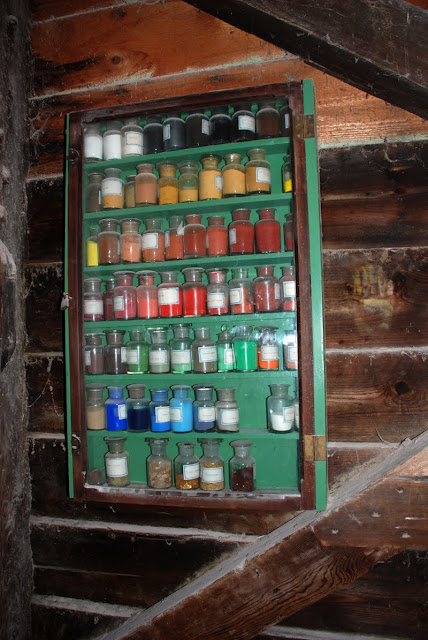People in the past were more Fidgety Fingers'ish than they are now. When they have less resources in the past, they resorted to be more creative and resourceful. It is very endearing how Man came out with certain devices and natural resources to make their lives better. Well, of course we are all depending on man-made energy for efficient. It is all about efficiency now. What would happen if we were not to have these luxury one day? Would you be resourceful enough to make things, weave, cook from scratch...?
We visit this windmill in Holland. De Kat (The Cat), Dye mill on the Kalverringdijk, Zaanse Schans, Zaandam, The Netherlands.
About ten years ago the production and sale of antique paints and dyes were resumed. this windmill is probably the last wind-powered dye mill in the world. This is all that is left of an industry which once comprised 55 dye mills and was associated with famous names such as Pieter Schoen, Storm, Van Bentum & Kluyver, Heyme Vis, Kuyper, Pieter Latenstein Pz., Avis and others. They colored our past.
THE ZAAN
The story begins outside, just around the corner! There is the river Zaan. The people who lived along its banks, and who had grown rich through trade and fishing, built their first windmills around 1600. Initially they used the wind to keep their feet dry, but later on they use it to develop an entire industrial area. Barley, rice, paper, wood, cooking oil, mustard, tobacco, hemp and many other products were processed in 1,000 windmills in the Zaan area. From 1850 on the work of the windmills was taken over by soot-spewing steam engines.
Only 13 windmills survived, as monuments of industry and technology.
 THE WIND
THE WIND
It is the wind, a rather capricious source of energy, that makes our windmills work (or not work, as the case may be!). But they cannot work without the miller, who turns the sails, mounted on the 15-ton cap, into the face of the wind. He also regulates the speed of the windmill by means of the sails and boards.
COLOR
This product of the windmill is color – or rather, dyestuff! From 1600 onwards tropical dye woods were imported on a large scale in order to dye fabrics. They heavy pieces of wood were cut into chips by choppers of a big vat. The chips were then pulverized by edge runner stones weighing 5,000 to 7,000kg and later sifted in a rotating drum. They were then packed into bales or barrels and delivered to the customers. Just before 1700 the windmills were also put to use to process mineral dyes, chalk and abrasives. The wet stones, which came from quarries, first had to be dried off in warehouses. Painters made paint by rubbing the dye powders into a medium such as linseed oil.
We visit this windmill in Holland. De Kat (The Cat), Dye mill on the Kalverringdijk, Zaanse Schans, Zaandam, The Netherlands.
About ten years ago the production and sale of antique paints and dyes were resumed. this windmill is probably the last wind-powered dye mill in the world. This is all that is left of an industry which once comprised 55 dye mills and was associated with famous names such as Pieter Schoen, Storm, Van Bentum & Kluyver, Heyme Vis, Kuyper, Pieter Latenstein Pz., Avis and others. They colored our past.
THE ZAAN
The story begins outside, just around the corner! There is the river Zaan. The people who lived along its banks, and who had grown rich through trade and fishing, built their first windmills around 1600. Initially they used the wind to keep their feet dry, but later on they use it to develop an entire industrial area. Barley, rice, paper, wood, cooking oil, mustard, tobacco, hemp and many other products were processed in 1,000 windmills in the Zaan area. From 1850 on the work of the windmills was taken over by soot-spewing steam engines.
Only 13 windmills survived, as monuments of industry and technology.
 THE WIND
THE WINDIt is the wind, a rather capricious source of energy, that makes our windmills work (or not work, as the case may be!). But they cannot work without the miller, who turns the sails, mounted on the 15-ton cap, into the face of the wind. He also regulates the speed of the windmill by means of the sails and boards.
COLOR
This product of the windmill is color – or rather, dyestuff! From 1600 onwards tropical dye woods were imported on a large scale in order to dye fabrics. They heavy pieces of wood were cut into chips by choppers of a big vat. The chips were then pulverized by edge runner stones weighing 5,000 to 7,000kg and later sifted in a rotating drum. They were then packed into bales or barrels and delivered to the customers. Just before 1700 the windmills were also put to use to process mineral dyes, chalk and abrasives. The wet stones, which came from quarries, first had to be dried off in warehouses. Painters made paint by rubbing the dye powders into a medium such as linseed oil.












No comments:
Post a Comment